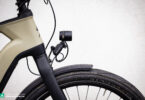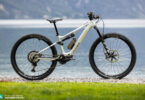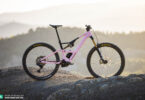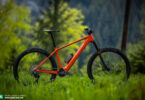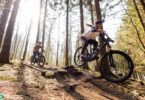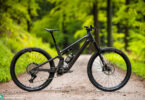With the free Family & Friends “Measure me” set, SQlab want to offer bike fitting for home use, focusing on the right choice of saddle, grips, and insoles. But do measurements you’ve taken in your kitchen really make a difference when you’re out on the trail? We tested it.

Burning thighs, sweaty T-shirts, limp arms – mountain biking can certainly be exhausting. However, additional “blood, sweat and tears” such as numbness or aching knees shouldn’t have to be part of it. That’s where SQlab comes in, offering what the professionals take for granted to the ordinary rider: a personal bike fitting to make riding more comfortable. With the free “Measure me” set, the company aims to help as many riders as possible take their first step into this unknown territory. The set allows everyone to determine their individual measurements, wherever they like. After all, not everyone is comfortable having personal conversations about their anatomy in the bike shop. Many would rather do the measuring themselves, comfortably within their own four walls. Sit bone, grip size, and foot type measurements are the basis for choosing the right products. But can a free kit to use at home really help determine what you need out on the trail? We decided to find out whether the “Measure me” set is worth trying.
Who are SQlab anyway?
Founded in 2003 in Straßlach near Munich, SQlab specialise in the ergonomics of the three contact points between rider and bike: foot, pelvis, and hand. Consequently, the SQlab product range includes everything from saddles to handlebars to grips to insoles. We paid them a visit and peppered them with questions. Since the very beginning, SQlab have used a sit bone measurement system for their saddles. This has now been expanded to include additional measurement points, such as grip size and foot type measurements, to provide even more accurate data for the rider. The measurement kit is available easily and free of charge within the EU and North America on the SQlab website and includes two card measuring tools, instructions, and a product overview to help you choose the right products.
How the SQlab “Measure me” set works
To measure your sit bones, you’ll need a flat, hard chair or stool to place the cardboard on. Sit down and raise your knees slightly, pulling against the underside of the chair with your hands to make an imprint of your sit bones in the cardboard.


Mark a circle around the imprints, then measure the distance between the centre of the circles, and you’ll get your sit bone width.


Then, depending on your riding position and riding style, add 1–4 cm to the measurement to determine the saddle width that you need. Be careful: slipshod measuring will distort the result, which might make you choose the wrong size saddle.
To determine the grip size, the kit contains a hand chart. Align the top of the middle finger with the tip of the marked arrow. By spreading your thumb slightly and marking the crook of your thumb, the template indicates your grip size.



The SQlab set also includes a foot type measurement. For this, step barefoot on the chart, trace the outline of your foot with a pencil and use the enclosed drawings to determine your foot type. In a second step, you need to determine your leg axis: are you rather bow-legged, knock-kneed or straight-legged? Using both results, you can choose the appropriate insoles. The entire set is called Family & Friends, but you can largely do the measurements on your own, except maybe when drawing your foot: here, you will benefit from someone’s help for an accurate measurement.

Sit down and hold tight: the SQlab “Measure me” set in use
As for ease of use, the SQlab set leaves nothing to be desired. The enclosed instructions for the individual steps are clear and simple, and should be easy to follow – particularly if you watch the accompanying YouTube video.

Of course, not even the clever low-tech solution by SQlab can replace a test ride or a bike fitting by a pro. Human anatomy is simply too individual for that. However, it provides some surprisingly precise indications, which should help to significantly shorten the selection process for the right components. In our experience, the first test ride showed that the test process worked well. While Bene did have to tweak the saddle angle a little after a few kilometres to address some perineal discomfort, he found the width and overall shape of the saddle comfortable. After a few weeks of testing, he hadn’t experienced any issues, and while he didn’t have any problems with his previous saddle, he’s planning on keeping the SQlab as it was a slightly better fit for his anatomy. If your chosen saddle doesn’t quite feel right, SQlab offer some additional adjustment options, using rubber elastomers to tweak the fit slightly. If you’re still not comfortable, you can send it back within 30 days to try something else (or get your money back).

The SQlab Family & Friends “Measure me” set is a useful tool for riders who don’t get on with their factory-fitted saddle, and don’t want pain to get in the way of their hobby. It is, however, no substitute for a proper bike fitting. Ultimately, there is no getting around a test ride, and you certainly shouldn’t cling to a measurement if it turns out to be the wrong saddle width for you. Nevertheless, the free set serves as a useful reference point, and is definitely a useful tool to have in the kit.
Tuning-Tipp: If the saddle pinches a little at first, lower the saddle nose slightly.
Tops
- free measuring tool
- easy to use
- offers precise reference points
Flops
- if the measurement of the centres of the sit bones is not exact, the result will be distorted
For more information visit sq-lab.com
Did you enjoy this article? If so, we would be stoked if you decide to support us with a monthly contribution. By becoming a supporter of E-MOUNTAINBIKE, you will help secure a sustainable future for high-quality cycling journalism. Click here to learn more.
Words: Benedikt Schmidt Photos: Antonia Feder














